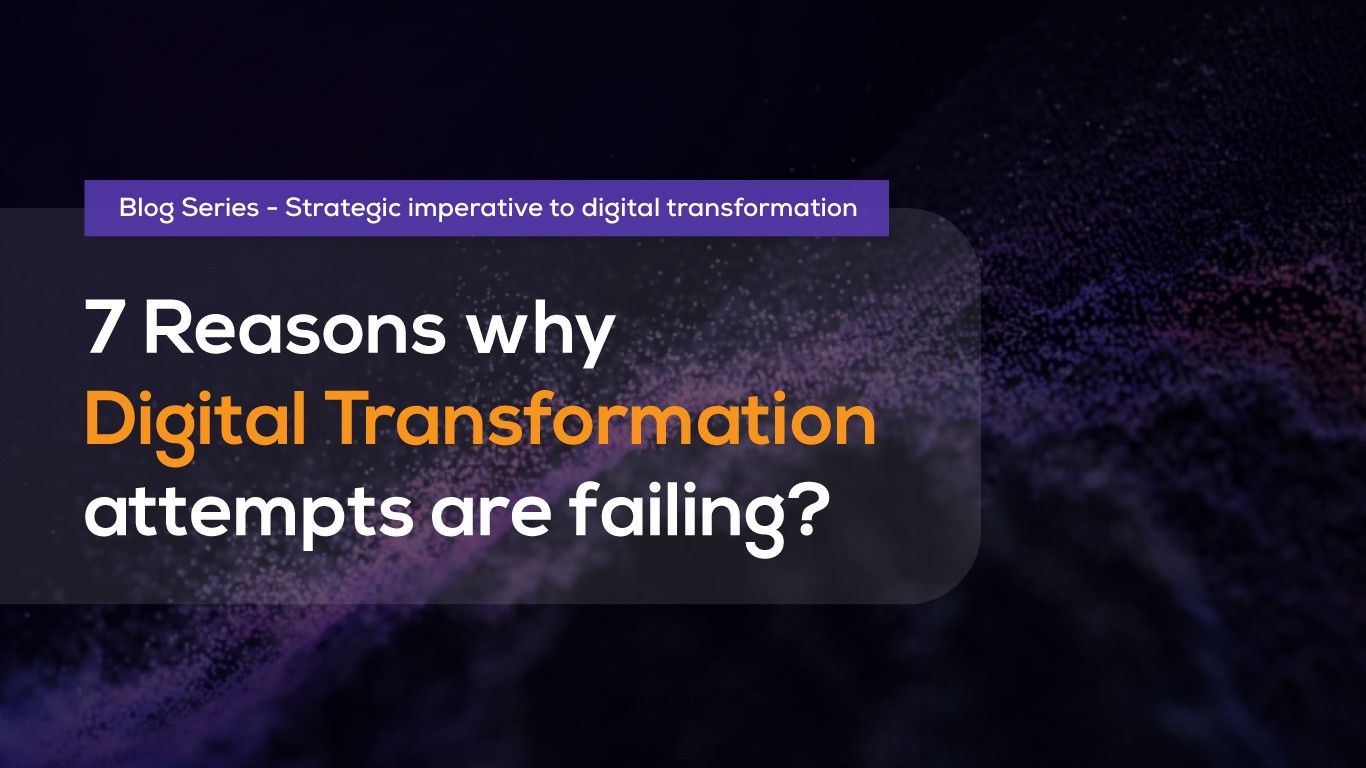7 Reasons why Digital Transformation attempts are failing?
Short Summary - Despite understanding the importance of digital transformation, leaders are failing to get it implemented in this digital world. What are the reasons why organizations fail in digital transformation implementation? Let us dive in to explore more!
From being a buzzword to becoming an imperative medium to scale the organization, digital transformation is the beat on which every flourishing system wants to dance. In an era of rapid digitization, businesses tend to fail no matter the size of the business, and this is due to the missteps leaders take that lead to failure.
However, many digital transformations fail, so it’s hard to get value out of them, even though most companies have, presumably, invested a relatively substantial volume of resources in digital and tech. While 30% of enterprises achieve their desired business results from digital transformation efforts, 70% of digital transformation initiatives fail short of meeting their business objectives.
The point of digital transformation isn’t to become digital. Digital transformation is a continuous evolution. Leaders treat digital transformation as a point in time that is needed to be done rather than taking digital transformation as a real muscle that helps enterprises to continue getting better and better as they go on. Organizations tend to fail more when they view digital transformation as another box they need to check.
Organizations can leverage an enterprise-wide digital strategy to generate value for the business—and can have a clear, integrated, top-down road map where the primary goals, such as reduced costs, higher revenues, and increased customer satisfaction. Fundamentally redefining an organization’s business operations and customer experience through digital technologies & right tools might lead to successfully transforming a company that’s stronger and more agile than it previously was.
Smart organizations with innovative leaders lay the below groundwork for a successful digital transformation.
Otherwise, if organizations don't approach it from that kind of business and customer perspective, the digital transformation efforts might drive their organization to a position of failure. So why do digital transformation initiatives fail? This overview of the top seven reasons why organizations encounter digital transformation failures will show why failure is still the norm and guide how organizations can detour these hindrances.
Seven Reasons for Digital Transformation Failure
1. Absence of a digital strategy & goals
Organizations embrace the digital transformation process without having a solid understanding of what it looks like and this is the first and foremost reason why companies still face trials and tribulations on their journeys toward digital transformation.
Leaders and CEOs can play a pivotal role in stirring things up, reconsidering the company's business vectors, and thinking beyond the tools to welcome back the presence of digital transformation. Understanding the business problem, creating a digital transformation roadmap, and bringing people mindset change are half of the solutions.
By identifying the exact business goals to formulate a strategic vision for digital transformation and making your people understand that this future digital transformation process is an essential step toward success.
2. Lack of change management
The absence of change management can make or break an organization's digital transformation initiatives. If CIOs have a clue on how to change the mindsets and behaviors necessary from the very beginning, then only they will be successful in sustaining digital as a transformation enabler.
Existing successful change management includes people who are positive to change and more successful with digital transformation are going to be the right people who are ready to embrace change, collaboration, and productivity on the digital wave.
To further cascade to other employees, CIOs who act as an engine for change and education should create measures that encourage different groups within departments to work together more coherently and effectively.
Via ethics and conduct organization can set effective change management and the right people who can place culture at the center of digital transformation and lead training and education to influence other employees to become digitally savvy.
3. Missing Proof of Concept with the right technology
Despite understanding the importance of technology for organizations, leaders fail to adapt to the digital world due to new & complex technologies owing to the shifting consumer expectations, challenging norms, and pressuring organizations to respond. As technology disrupts businesses fundamentally, organizations need to be more agile.
The digital transformation journey encompasses much more than simply rolling out apps or redesigning a website. It's about fundamentally redefining an organization's business operations and customer experience through digital technologies and creating a more robust and agile company than it previously was. All these demands for validating Proof of Concept Software and tools are designed to be more effective, but if we don’t adopt the right technology, it turns counterproductive.
Re-evaluate front and back-end systems for seamless, integrated, native customer experiences and, ultimately, employee experiences. Stack of technology aligned with new security and compliance infrastructure promotes trustworthiness and meets ever-increasing customer expectations. Ensure your content and communications are platform-proof, so that algorithm changes do not interfere with customer experiences.
Focusing solely on enabling technology can lead to failures. Technology alone won't help organizations bridge the gap, and digitization has as much to do with people as with technology. Organizations have to approach platforms that bring people and technology together via shared strategy, objectives, and measures while validating the Proof of Concept that they have for their future strategy.
4. Adoption of new tools & technologies
Organizations are slow to accelerate the prototyping and industrialization of emerging technologies related to health and wellness, cybersecurity, and zero emissions. Organizations are going through a collective fear of a significant technological transformation and moving forward with modern technology adoption.
Enterprises, especially SMEs, have less money to invest in experimenting with new technology than is needed to increase revenue.Another reason for slow adoption could be the lack of awareness of emerging technologies among systems as businesses keep technology change as a “lack of urgency”. Moreover, SMEs won’t have enough technology experts to communicate the strategic benefits of new tools and the values of new technologies.
With the rapid pace of technology innovation, the possibility of addressing the problems of existing solutions with features can combat current security threats. With the help of human intelligence, emerging new technologies will empower the ability to detect threats earlier before they are exploited; thereby, you can reduce the damage and quickly restore your system.
5. Interfaces for evolving customer experience
Customers are used to multichannel experiences in an increasingly digitized world, and they expect companies to deliver similar experiences across offline and online channels.
To build a digital transformation that will last for the long run, a company must clearly understand its customer needs and try to meet them with engaging interfaces having compelling user interfaces to render exemplary user experience. The organization fails to achieve the company’s overall strategic objective of creating a digital-first customer experience.
Companies can bridge this gap by making the customer experience a top priority and putting customers at the center of every strategy for digital transformation. This can represent a variety of initiatives, from building a mobile-first customer journey to merging in-store and online shopping, digitizing support channels, reducing customer wait time, creating intuitive interfaces, and much more. A company can also create a tech innovation that uses human intelligence to improve customer and retailer experience.
These improvements fulfill the expectations of today’s buyers, increase customer acquisition, and increase efficiency & profitability.
6. Reimagining digital & IT skills
Leaders fail to choose the right internal people and adequate resources that can contribute to the transformation. Developing talent and skills throughout the organization is one of the most important factors for success in a digital change effort.
Success requires a digital-savvy and other technological workforce with the capabilities to make a digital transformation happen.
To focus on disruptors rather than disruption, the key to innovation in the face of disruption is the use of creative teams interested in embracing digital changes.
A key advantage to creative teams is the enhanced access to resources, such as diverse perspectives, broader skill sets, and new ideas such as an excellent design by UI/UX designer will boost the audience engagement of your company, simplify interactions with buyers, and help you be always effective in the online space. Creating an adaptive organization starts with talent that can quickly reskill or upskill for future changes.
But finding people with the right skills for your digital transformation team can be a challenge. There's still a shortage of talent in high-demand human intelligence.
7. Rising internal security concerns
Security is a top concern for firms as they deploy applications or new technologies to grow business. In fear of failure, the most worrying concern in several companies is data security breaches and information security problems.
Leaders need to have new security and compliance infrastructure and work to transform security teams to manage digital risk and bring the IT culture. The challenge for security teams remains how to add security at the speed of digital transformation and make sure to bring new security and compliance infrastructure in a place considered from the outset.
Keeping cybersecurity among their top considerations and investment in robust security frameworks can be meaningful for digital transformation.
Conclusion
While many say digital transformation falls short in boosting productivity and equipping changes, lessons can be learned from those who report success. Successful companies have adopted both digital-savvy leaders and a workforce with the capabilities to make a digital transformation happen. All organizations need to think critically about the seven reasons that could be pitfalls and the most common reasons for their digital transformation initiatives going wrong.
One critical step is for organizations to develop clear workforce strategies and identify the skills they will need to make digital transformation an era to live in. Organizations that understand that digital transformation is a journey integrated with strategic needs, team culture, and a long-term agile path will be the ones that come out on top.
Is your business on a digital pathway, and do you want it to be a digital giant? If yes, then we, at Global Lancers, are here to empower your businesses with Digital Transformation Strategy along with execution, ensuring scalability. We are here to equip orchestrated people and systems with the intelligent human skills to do the jobs you have now. Let us integrate with your existing systems while enabling the power to transform your business digitally.
Recent Posts








Add Comment
0 Comments